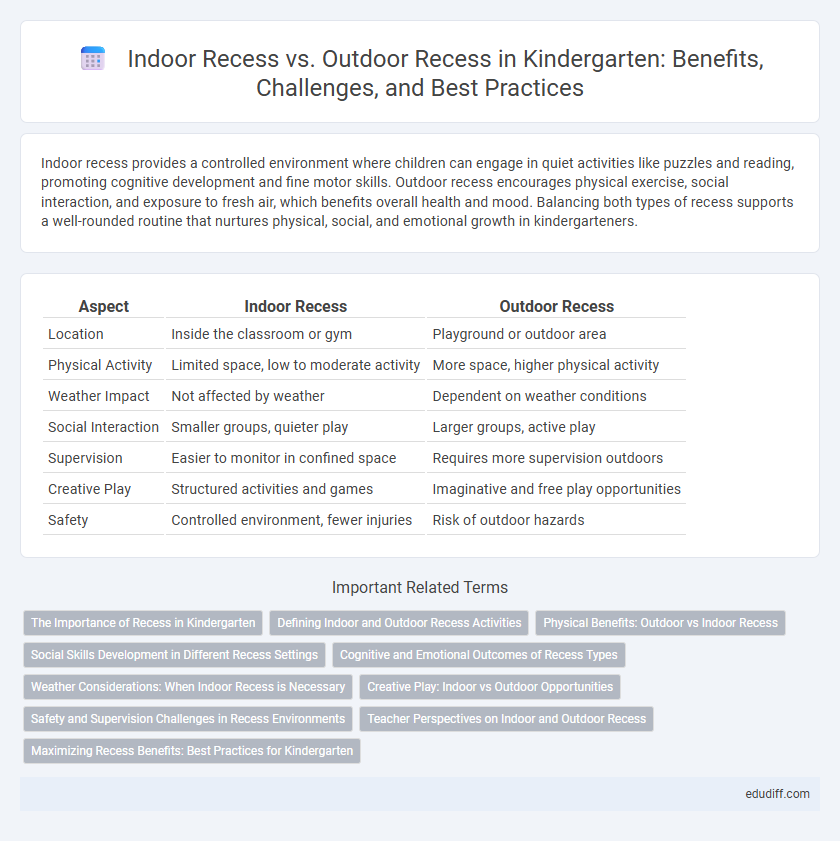Indoor recess provides a controlled environment where children can engage in quiet activities like puzzles and reading, promoting cognitive development and fine motor skills. Outdoor recess encourages physical exercise, social interaction, and exposure to fresh air, which benefits overall health and mood. Balancing both types of recess supports a well-rounded routine that nurtures physical, social, and emotional growth in kindergarteners.
Table of Comparison
| Aspect | Indoor Recess | Outdoor Recess |
|---|---|---|
| Location | Inside the classroom or gym | Playground or outdoor area |
| Physical Activity | Limited space, low to moderate activity | More space, higher physical activity |
| Weather Impact | Not affected by weather | Dependent on weather conditions |
| Social Interaction | Smaller groups, quieter play | Larger groups, active play |
| Supervision | Easier to monitor in confined space | Requires more supervision outdoors |
| Creative Play | Structured activities and games | Imaginative and free play opportunities |
| Safety | Controlled environment, fewer injuries | Risk of outdoor hazards |
The Importance of Recess in Kindergarten
Recess in kindergarten plays a crucial role in promoting physical development, social skills, and cognitive growth. Indoor recess provides a safe and controlled environment during inclement weather, while outdoor recess offers opportunities for fresh air, gross motor activities, and natural exploration. Balancing both recess types supports children's overall well-being and enhances their learning readiness.
Defining Indoor and Outdoor Recess Activities
Indoor recess activities for kindergarten typically include board games, puzzles, storytelling, and simple crafts that promote fine motor skills and social interaction. Outdoor recess activities often involve running, climbing, ball games, and imaginative play, which support gross motor development and physical health. Both types of recess are essential for balancing cognitive growth with physical exercise in early childhood education.
Physical Benefits: Outdoor vs Indoor Recess
Outdoor recess promotes essential physical development in kindergarten children through activities that enhance coordination, strength, and cardiovascular health, unlike indoor recess which often limits movement due to space constraints. Exposure to natural elements during outdoor play supports motor skills and encourages active play, leading to improved overall fitness and reduced sedentary behavior. Studies show children engaging in outdoor recess exhibit higher energy expenditure and better physical endurance compared to those confined indoors.
Social Skills Development in Different Recess Settings
Indoor recess environments encourage cooperative play through structured activities and small group interactions, enhancing communication and conflict resolution skills among kindergarteners. Outdoor recess offers expansive space for physical games and spontaneous social interactions, promoting teamwork, leadership, and negotiation abilities in dynamic settings. Both recess settings contribute uniquely to the development of essential social skills, fostering empathy and collaboration in early childhood.
Cognitive and Emotional Outcomes of Recess Types
Indoor recess provides a controlled environment that minimizes distractions, supporting focused cognitive activities and promoting emotional regulation in kindergarten children. Outdoor recess encourages physical activity and social interaction, which enhance executive function, problem-solving skills, and emotional resilience. Balancing both recess types can optimize cognitive development and emotional well-being by combining structured learning with natural play.
Weather Considerations: When Indoor Recess is Necessary
Indoor recess is necessary during extreme weather conditions such as heavy rain, snow, or temperatures below 32degF (0degC), ensuring children's safety and comfort. Poor air quality, including high pollution levels or pollen counts, also mandates indoor play to protect respiratory health. Schools prioritize monitoring local weather forecasts and environmental alerts to decide when recess should be moved indoors.
Creative Play: Indoor vs Outdoor Opportunities
Indoor recess encourages creative play through structured activities like arts and crafts, building blocks, and imaginative games that stimulate cognitive development and fine motor skills. Outdoor recess offers expansive space for active play, fostering creativity through physical exploration, natural materials, and social interactions in unstructured environments. Both settings support different aspects of creative play, with indoor recess emphasizing focused, hands-on creativity and outdoor recess promoting spontaneous, movement-based innovation.
Safety and Supervision Challenges in Recess Environments
Indoor recess offers a controlled environment that minimizes risks associated with weather and playground equipment, enhancing student safety. However, limited space and higher noise levels pose supervision challenges, requiring vigilant staff to maintain order and prevent accidents. Outdoor recess provides natural physical activity opportunities but demands stringent supervision protocols to address visibility issues and potential hazards like uneven surfaces or equipment misuse.
Teacher Perspectives on Indoor and Outdoor Recess
Teachers emphasize the importance of outdoor recess for promoting physical activity, social skills, and improved focus during classroom activities. Indoor recess is often viewed as a necessary alternative during inclement weather, but educators note it can limit children's movement and energy release. Many teachers advocate for creative indoor recess activities that encourage active engagement to compensate for reduced outdoor playtime.
Maximizing Recess Benefits: Best Practices for Kindergarten
Maximizing recess benefits in kindergarten involves balancing indoor and outdoor play to support physical, social, and cognitive development. Outdoor recess offers opportunities for gross motor skill enhancement, exposure to nature, and social interaction, while indoor recess can effectively incorporate creative activities, quiet games, and sensory play in adverse weather. Integrating structured playtime with free choice during both indoor and outdoor recess ensures comprehensive developmental gains for young learners.
Indoor Recess vs Outdoor Recess Infographic

 edudiff.com
edudiff.com